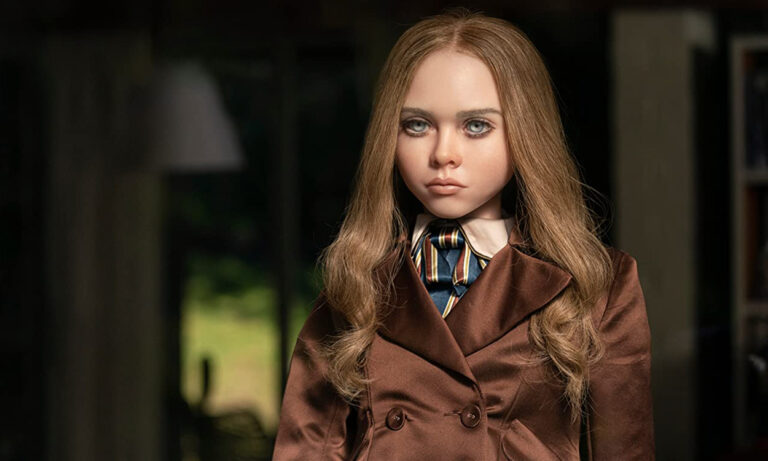M3GAN: A living meme that the wider movie industry should take very seriously
After months of waiting, the moment had finally arrived: I was sitting in the cinema, about to watch M3GAN for the first time.
The new science fiction horror film is a collaboration between legendary horror producers James Wan and Jason Blum and screenwriter Akela Cooper, who brought us 2021’s psychotic parasitic-twin epic Malignant. I’d love to tell you that the production company, the film’s screenwriter or perhaps its director, Gerard Johnstone, were why I felt like I simply had to see it. But that would be a lie, like the ones killer AI bot M3GAN quickly programmed herself to tell.
The real answer is much more simple: I did it for the memes.
Ever since the first M3GAN trailer dropped in October 2022, the film has been a living meme. After catching their first glimpse of M3GAN, Gay Twitter quickly gave the doll queer icon status. “She is serving,” “she ate,” “she is mother,” “the new IT girl”—you name it, it’s been said. Before the movie had even hit the theatres, I had seen more self-made fan-cam videos for this murderous doll than I could have wished for.
She’s ending all dolls honestly! pic.twitter.com/YIyOOyhC5H
— ~JayKay~🌙 (@clouwdstone) October 11, 2022
As a gay man who spends more time online than is recommended, it felt like watching M3GAN was my gay civic duty. After all, she’s a triple threat—she can sing, dance and kill—with a strong Real Housewives energy. It’s no surprise then that publications from Vox to Out and Them have all attempted to unpack M3GAN’s queer appeal.
More broadly, though, the American science fiction horror film says a lot about the role memes and social media have played in its promotion and the fandom that has resulted from it.
Speaking to Vulture, Get Out sensation and M3GAN’s star and executive producer Allison Williams—who plays Gemma, a roboticist at Seattle toy company Funki, who creates the doll—said that the team behind the film weren’t always sure whether they had struck the right balance between funny and scary. Before Williams even got to watch the film in the cinema with fans and see their reactions, it was when she came across the countless memes online that she thought: “We can go home, our job is done.”
There is a clear contrast in how M3GAN’s character is perceived by fans, compared to in the movie. Part of the reason why she is so ‘memeable’ to the audience is because, in the world we see her inhabit on-screen, she is taken completely seriously. She isn’t seen as remotely fabulous. To her inventors, she’s just a toy. But to fans? She’s so much more.
The memeability of M3GAN isn’t something that those behind the film have passively watched from the sidelines. In fact, the promo has leaned into M3GAN’s status as a darling of the internet. After the #m3gandance picked up traction on TikTok—with currently 226.7 million views generated—real-life stunts began to follow.
Groups dressed as a squad of M3GAN dolls posted videos from the New York City subways, shocked pedestrians outside Radio City Music Hall, and danced at the top of the Empire State Building. At the movie’s premiere, M3GAN lookalikes danced to Taylor Swift and, in Los Angeles, another M3GAN group performed their scary dance at a football game. In the film, M3GAN’s goal is killing. But in the wild, her goal is to go viral.
hey @ScreamMovies me and my besties are here and ready for u. let’s see who screams first 😱 pic.twitter.com/oHrZzUU6D1
— M3GAN (@meetM3GAN) January 5, 2023
Universal Pictures sent this group to last night’s Chargers-Rams game to promote its new movie, “M3GAN” 😳pic.twitter.com/SlzaIVGN00
— Front Office Sports (@FOS) January 2, 2023
When I interviewed Williams about the film for GQ, she told me a key part of M3GAN’s success so far has been that the movie is roughly what audiences expect it to be. “It all depends on what the audience is coming into the theatre prepared to experience,” she said. “And audiences have been coming into M3GAN prepared to have fun and be scared.” Memes have been a major part of crafting that perception.
The fun irreverence of M3GAN, which seems tailor-made for platforms like Twitter and TikTok where—politics aside, of course—there can often be a distinct lack of seriousness. This is visible in the film’s carefully chosen release dates. It came to UK theatres on Friday 13 January, having been released in the US on a now-even-scarier date: 6 January.
The timing of the film hitting theatres might also be driving its memability. We’re in the middle of awards season, when most films are branding themselves as inherently ‘serious’ and spoken about in gushing, artistic terms. For Oscar contenders, becoming a meme might be seen to take away from their overall message or ability to be considered ‘high art’.
But upending these binary and restrictive notions is in the horror genre’s DNA. Against a backdrop of awards season, the shameless silliness and fun of M3GAN feels like a welcome (and slightly naughty) release.
Yes, the M3GAN memes are hilarious. But they’re more than that: they tell a story about how memes have become the new ‘word of mouth’—a vital part of promoting a film, creating buzz and preparing the audience for what they’re about to see. The movie and its promo have both been crafted for the new digital landscape, where social media users have just as much power as critics. Despite its unapologetic hilarity, M3GAN is a digital success story that the wider industry should take very seriously.





